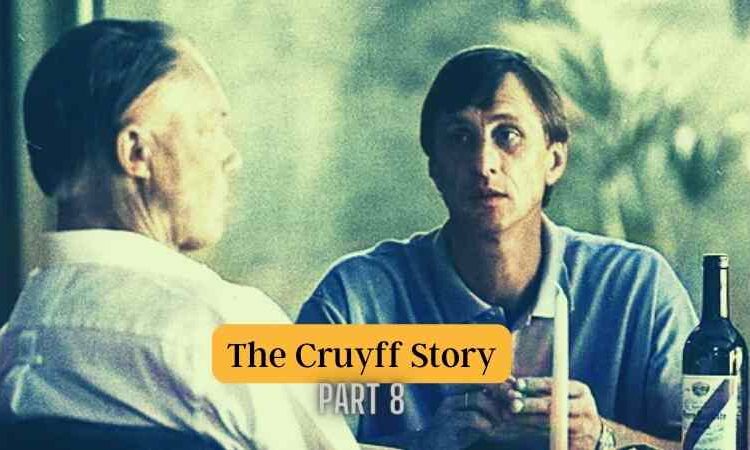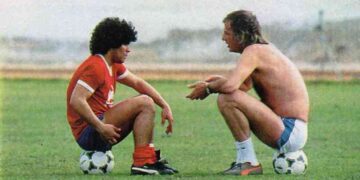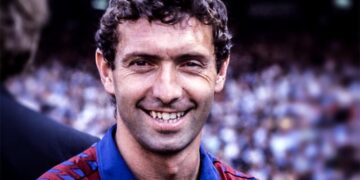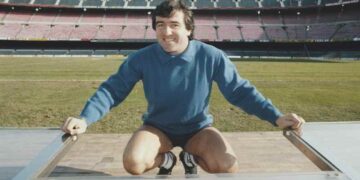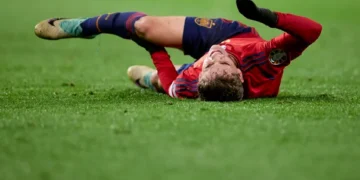‘Cruyff is an ordinary, ill-mannered, incomprehensible Dutch-speaking (i.e. mumbling), extremely immature, irritating dick, who suffers from self-overestimation and literally thinks of himself as a kind of god. Horrible.’
According to mister Leutscher from Strijen.
On the editorial boards of newspapers and magazines it rains entries for the letters section after on December 19, 1993, just before the WC draw in Las Vegas, it became clear that Johan Cruyff will not be a national coach at the upcoming World Cup final round. Just like four years earlier. The KNVB has had enough of all his additional requirements and a total lack of communication, and switches definitively to Dick Advocaat.
The critics see it as confirmation of the image they already had of the so-called Savior. Among them also international John de Wolf. ‘I don’t care’, the defender sounds almost relieved. And Rinus Israël, who realizes that the abandoned negotiations with Cruyff mean that he will go to the US as an assistant to Advocaat, already foresees problems: ‘Dick, like Leo in 1990, has nothing to gain. The spirit of Cruyff will continue to haunt us in America. That was also the problem in Italy. If Advocaat reaches the semi-finals, the outside world will reason that the final would have been possible with Cruyff as national coach. Fun is different.’
This is Part 8 of #TheCruyffStory.
The vast majority of the group of players groans with disappointment just before the holidays. “This message hits me like a bomb,” Bryan Roy shakes his head in disbelief. ‘Johan Cruyff brought me to Ajax as a player. I was always crazy about him…’ Frank de Boer: ‘I experienced him two matches at Ajax. I thought it would be fantastic to work with him in the US.’
Marco van Basten, who has been living between hope and fear for some time because of that cursed only but is still seen as the footballer who is perhaps closest to Cruyff, is also initially disappointed. “It’s such a shame for football that Johan won’t be there,” he said. But if he and Cruyff around the turn of the year joins a special broadcast of Barend & Van Dorp from Barcelona, he is frustrated. “You should have just done it,” he grumbles to his teacher, “and not whine like that.” Van Basten also finds it ‘strange that his friend always talks about money’, because, he says, ‘that’s not the point at all, is it?’
In an extensive interview with VI, Cruyff tries to explain a week later why he can hardly be blamed, that someone may have played a dirty game. That he would have loved to have done it. “I wanted to be world champion.” A mission in which he firmly believed, he says. Whether it had ended with the world title? ‘You never know for sure. You can always lose a final.’
Tough Early Days with the Dutch NT
From 1966, when the KNVB suspended him for a year after an alleged blow to referee Rudi Glöckner during the Netherlands-Czechoslovakia, Cruyff was regularly at odds with the association. National coach George Kessler did not select him in 1969 for a duel with Bulgaria because he had reported too late in the training camp. Then you had the disagreement with the PSV’ers Willy van der Kuijlen and Jan van Beveren, the constant tug-of-war for merit and sponsor, the cancellation for the 1978 World Cup and therefore the missed national coach ship in 1990. At the end of 1993 may Dutch people thought that Cruyff was one big runaway.
It’s great when you see the numbers. Of the 132 matches that the Dutch national team has to choose between his Orange debut in September 1966 and the championship he celebrates with Feyenoord in 1984, as a memorable final piece of his active career, Johan Cruyff played no more than 48. That’s about a third…
Not a pro environment like today
“I could have been a record international at my leisure,” he realized. ‘But it was locked up at that time. Arguing about contracts, arguing about sponsorship, about insurance and so on. Everything that is now well arranged, we had to argue about. I was a professional at Ajax, but if I was sent off from the Dutch national team, I could be suspended for the competition. It was very primitive, but I thought: If it’s not okay, find someone else.’
In a trainer’s costume, in his case an old-fashioned long raincoat, it did not come to one international match. This was the answer when asked if it didn’t bother him that he had missed a World Cup twice: ‘Cross, cross. It must have been good for something. I acted the way I thought I should. In addition, you should not confuse two things: the person and the professional. The professional says: If I do it, I want so-and-so organization and otherwise I won’t do it. If it doesn’t go through, okay, sans resentment. That’s their problem. It turned out that they did it wrong, because given the qualities of the footballers, more should have come out of it.’
The generation that could and should have harvested much more after 1988, fell through the basket in Italy two years after the European gold and had to go home there under the leadership of Leo Beenhakker after the eighth final. In 1992 it ran under the returned Rinus Michels piece against tournament-surprise Denmark and also in The Land of Opportunity it turned out to be a fairly hopeless exercise. Dick Advocaats Orange was eliminated in the quarterfinals by the later world champion Brazil.
Ready to take control
Under Cruyff, everything would probably have gone differently, Cruyff judged. ‘If the Netherlands needs me, I’m always ready’, he once said. ‘There has to be quality and I want to put together my own team, but I’m the ideal man to be the national coach during a World Cup.’ In any case, the ideal man to attract attention to the Orange with spectacular, often hyper-attacking football. Also given this statement: ‘As long as I have something to say somewhere, I will continue to play according to my vision. And if they think I’m a lunatic, I have nothing more to say. Then I won’t stay in football. You don’t think I’m going to adapt, do you?’
Already in the run-up to the European Championship 1988, Cruyff imagined if he was in the position of national coach Rinus Michels for VI. He even sketched a line-up that could have been used at the World Cup in Italy two years later.
“I am convinced that the Dutch national team has the strongest axis of the European Championship,” Cruyff said. ‘Ronald Koeman, Frank Rijkaard, Ruud Gullit and Marco van Basten, no country can compete with that. Those four guys master all parts of football. They can really play football, pass, shoot, head, open, duel, defend, attack, pass and score. You fill in the rest of the team around that axis.’
A different approach to the game
At that time, most teams organized from a flat 4-4-2. Cruyff countered with a 3-4-3 formation with a diamond in midfield. And a length axis of four men with a last defender, a sliding defender, a number 10 and a center striker. For those positions, Cruyff had three players in mind with whom he had previously worked at Ajax in this system: Koeman, Rijkaard and Van Basten. Gullit was added as a shadow striker.
The other players had to play in the service of this quartet. “We have enough controlling midfielders,” Cruyff said in 1988. ‘Jan Wouters, Arnold Mühren, Erwin Koeman and Aron Winter, take your pick.’ Since Mühren had retired two years later, Erwin Koeman could have joined the outlined team. For the opponent’s two strikers, Cruyff already had his defenders in mind: ‘We have no shortage of good backs either. Adri van Tiggelen, Berry van Aerle and Sjaak Troost are all capable of doing that.’
Only the wingers were a point of concern to Cruyff. ‘I admit that the wing formations are not ideal, but John van ‘t Schip has proven in the past that he can play well on the left wing, while Gerald Vanenburg can play right winger.’
Where Rinus Michels decided in 1988 to solve this after a false start by playing 4-4-2, Cruyff came to very different conclusions. ‘The result was ultimately brilliant in 1988, but the way in which the Netherlands became European champion and how they played was not so convincing in my eyes.’
Looking for something different
Cruyff argued that it would be wise to let the tactics depend on the opponent. ‘The basis is excellent: Marco van Basten, Ruud Gullit, Frank Rijkaard, Jan Wouters, Ronald Koeman and Adri van Tiggelen. The other positions have to be filled per game.’
England’s 4-4-2 could be played in the second group game of the 1990 World Cup according to the tactics he described two years earlier. After the tournament, Cruyff called it ‘ridiculous’ that four defenders had been played against England and asked himself how it was possible that Egypt had more possession.
‘The midfield is the scale of your team’, was his analysis. “If you play with two midfielders and the opponent with four, you never win. If you keep four people in the back against one striker, you will be two short somewhere. So I’ve always played with one defender more than the opponent had in strikers. If he plays with two strikers, playing with three defenders is not risky, is it?’
After the World Cup in Italy, Cruijff further elaborated that idea in conversation with Barend & Van Dorp for Nieuwe Revu magazine. “Do you know what the error is? That people think that countries like Egypt can play football. Of course, if you give them space, they can do anything with a ball. Anyone can play football with five meters of space. Then you have time to think, you do not have to act quickly, you do not have to decide quickly, so you do not panic quickly. Then Egypt is also a team that can run reasonably well. So you don’t give them space. The same player who can still do everything with five meters of space, if he only has two meters of space, will lose ball, panic.’
The World Cup in 1994 was different
While Cruyff was still very outspoken about his tactical plans in 1990, four years later he wisely held the cards a bit more to the chest. What is certain is that even then he felt that they played far too defensively. ‘When the Netherlands fell behind 2-0 against Brazil, it was Hail Mary. Everyone did what they wanted and what they could do on their own, and Brazil immediately got into a lot of trouble. Why couldn’t that be the whole game?’, he asked himself after the elimination in the quarterfinals.
It is no coincidence that the Orange team switched to a 3-4-3 formation with a diamond in midfield in that phase described by Cruyff against Brazil. With that system, he had become champion with Barcelona as a coach for the previous four years. Louis van Gaal also played that way at Ajax. With many young players who were still brought to the training by Cruyff and his right-hand man Tonny Bruins Slot. With this Dutch team, the legendary Number 14 could have built on these types of confidants.
As the central defender, Ronald Koeman had been uncontroversial. Cruyff called him at his farewell as a coach the best purchase he had made at Barcelona. In that period he paired him with Pep Guardiola in Catalonia. ‘Both were not fast and not defenders’, he would later tell about this in his biography. ‘Yet we always played in the opponent’s half.’
Innovative approach to football
‘In addition, I made a probability calculation based on three passes that the opponent could give. First of all, the ball in the depth that was played over our last line. If the goalkeeper was lined up well and far from the goal, it was always for him. Then the crosspass. Before that I had fast backs, who were trained as wingers. They were always in time to intercept the ball. The third option was the play-in pass through the middle. Guardiola and Koeman were positionally so strong that it was always intercepted by them. Although they weren’t seemingly the ideal central defenders, that’s why it worked.’
In 1998, the Dutch team had a national coach with Guus Hiddink who could count on Cruyff’s support. Partly because Jordi Cruyff got minutes from Hiddink at Euro 96, the former top footballer had great respect for Hiddink. In contrast to the previous World Cups, this time there was no question of an appointment of Cruyff. From the sidelines, he did have a clear vision on how to get the most out of this group of players.
When Cruyff was confronted with the line-up against Argentina in his new role as analyst, he was clear: ‘It will not be my base, because I think differently about certain things.’
1998 World Cup was an opportnity
In conversation with VI, Cruyff expressed those thoughts during that World Cup in France. As with the previous final tournaments, he started with a plea for wingers. ‘The Netherlands can of course draft an extremely good team. No one in the world has such good wingers. I would play with Marc Overmars and Boudewijn Zenden. Or Dennis Bergkamp. That’s also an excellent winger. The way of playing also depends a bit on your opponents. If everyone plays without wingers, you have to play with wingers. Because you’re used to how they play, but nobody’s used to playing against wingers.’
Defensively, Cruyff’s starting points were also the same. You only need one more defender than the number of the opponent’s attackers. Finalists Brazil and France both played that tournament with one deep striker and without wingers. For Cruyff reason to slightly refine his tactics. “I would play with two defenders anyway. That’s all you need. Each opponent plays with one and a half strikers. The deepest striker is for those two men, Jaap Stam and Frank de Boer, and that false striker is taken care of by a midfielder with defensive qualities. Aron Winter is the ideal man for that position. Then you have three people who can play man coverage and in the position. Moreover, all three can play football and have insight.’
Finding the right solution
Because opponents did not draft wingers anyway, Cruyff had a radical solution in mind for the sides. ‘You don’t need backs, you have to put half wingers there. If you have a bit more imagination on the left and play offensively, you will have to play more conservatively on the right. One flank must always be tightly organized, otherwise it will be a mess. You need to know where the problems can arise and where they can’t. If they arise where you want them to, there is nothing to worry about, is there?
This is how Cruyff filled in his team step by step. “Then you have three men left,” he calculated. As with previous tournaments, Cruyff emphasized that it could be played with. “You can play with a deep striker, that has to be Patrick Kluivert, and two midfielders who support him. For example, Ronald de Boer and Cocu, but there are more who can play there.’
‘Or you play without a deep striker and make sure that people come from midfield. That’s how I always did it in Barcelona. Michael Laudrup and José María Bakero were very suitable for that. And it’s hard to defend. Bergkamp can play very well there. The setup itself doesn’t matter that much. It’s also a bit up to the opponent. The point is that the qualities pay off. So if you put Davids at left-back, it might be better to draft Overmars as a left winger. Because he likes to go in, you get an open flank.’
Bottom Line
Cruyff’s statements over the years demonstrate that his views were not as cast in concrete as has sometimes been suggested. Some principles, such as playing with wingers and striving for a diamond in midfield, always remained intact. At the same time, he moved with the spirit of the times.
When in 1988 most teams assumed 4-4-2, he believed in 3-4-3 with a diamond in midfield. Against teams with five defenders and one and a half strikers, according to Cruyff, it was also possible with one less defender. As in 1998, due to the emergence of systems with a deep striker and a number 10, he began to argue for a point backwards in midfield. The backs were suddenly deployed very offensively, where previously they had mainly been defenders.
For Cruyff, football was simply a game of space. And where they were, depended on the organization of the opponent. The most Cruyffian line-up for the upcoming World Cup is therefore different in every group game. Exactly that makes it such a pity that the fearless Cruyff never became a national coach. That had resulted in setups that were so insane that they were still being talked about.
Discover more from Barça Buzz
Subscribe to get the latest posts sent to your email.

